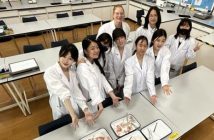
Assessing a school’s academic success was once just a matter of measuring students’ competence in the "three Rs": reading, writing and arithmetic. Courses were designed to provide children with very specific skill sets and as a result linear thinking was prioritized in an effort to ensure that students could “keep up” with their peers.
But developments in educational psychology over the last few decades have shown that there is more to learning than the old drill of “listen-repeat-remember,” and as work options have expanded, so too has the need to teaching children new skills beyond the three Rs.
It is imperative to take learning style into consideration when measuring academic progress. Newer learning theories attempt to provide additional ways of understanding and addressing the needs of children who do not do well under a more traditional system.
Hemispheric Dominance, for example, was first posited by Roger W. Sperry in the late 1960s. According to this theory, people predominantly use either the left or right side of the brain in learning (hence the terms “left-” and “right-brain learners”). So if a child tends to work sequentially, and in clear and often logical steps to build up a solution to a problem, Sperry believed that they work primarily with their left brain and would be considered a "traditional" learner who typically does very well in the three Rs.
Conversely, if the student tends to see the whole picture first (i.e. a more holistic approach) and fills in the details in the process of working out a solution, they would be labeled a “right-brain learner” with a more creative “out-of-the-box” approach.
Another notion that has shifted public attitudes towards learning is Howard Gardner’s Multiple Intelligences Theory. Based on the premise that there are “many kinds of smart,” this theory posits a range of “intelligences” ranging from linguistic and logical-mathematical to spatial, musical, bodily-kinesthetic, naturalistic, interpersonal and intrapersonal. Students who are “word-” and/or “number-smart” should theoretically do better in school under the traditional three Rs educational system.
But what about those whose strengths do not lie in either of these two areas? Based on research that he conducted from the 1970s to the late 90s, Gardner proposed that individuals draw on these multiple intelligences in order to solve problems that are relevant to the societies in which they live. Today, educators have applied the Multiple Intelligences Theory to alternative ways of teaching children, allowing them to grasp concepts more intuitively.
A third key development in educational psychology has been increased understanding of how developmental delays affect learning. According to the Developmental Disabilities Act (US) of October 2000, developmental disability is currently legally defined as “a severe and chronic disability in an individual 5 years of age or older that is attributable to a mental or physical impairment or a combination of both; is manifested before the person reaches age 22; is likely to continue indefinitely; results in substantial functional limitations in three or more areas of major life activity (self care, receptive and expressive language, learning, mobility, self-direction, capacity for independent living, economic self-sufficiency); and reflects the individual’s need for a combination and sequence of special, interdisciplinary, or generic services, supports or other assistance.”
Developmental delays can be manifest as consistently low scores on intelligence tests, poor academic functioning, and lack of adaptive skills. Sometimes, delays in motor development and in receptive and expressive language skills are also present. Special educators are armed with a wide range of learning theories that are necessary to understand and address the way an individual child learns best.
Whether learning difficulties encountered by the child are due to cognitive delays or behavioral challenges, the result is the same: The child’s academic performance is negatively affected, and their social development and self-esteem suffer as a consequence.
Additional learning support centers fill the gap where regular or mainstream schools are unable to meet some of the children’s needs. In some cases, these centers offer supplementary activities designed to help a student navigate school on their own. In other cases, the child’s cognitive or behavioral needs require addressing in a small school environment.
In Beijing, the following three centers can provide children with learning support services.
The Learning Center
The Learning Center (TLC) offers tutoring to students who need additional assistance after school. Teachers provide review and homework support to struggling students with the aim of completing schoolwork independently and raising their grades. Assistance can also be extended to students who are capable of doing advanced work outside the classroom, such as gifted students looking to enhance their skills in mathematics, science, and English as a foreign language.
Tutoring at TLC is available for grades K-12. The goal is to complement the program at each child’s school. The tutors regularly coordinate with teachers and/or learning support staff to provide help where it is most needed.
The center was founded in 2004 by Jennifer Sachs, an American teacher with over 20 years of experience in China. She and her team of qualified, native English-speaking educators run one-on-one, small group, and immersion classes in all key subject areas, including advanced English, science, math, humanities and English for Speakers of Other Languages (ESOL). TLC can help with SSAT, IGCSE, SAT, IB, AP, A-Level, and university entrance preparation.
Eliott’s Corner
Eliott’s Corner is a therapy center with a sister establishment in Shanghai called Olivia’s Place. It was founded in 2011 by Jacqueline Chen, the mother of a boy born with cerebral palsy. The center is named after her son, whose condition requires ongoing physical therapy.
Eliott’s Corner offers speech, occupational and physical therapy for children who have been diagnosed with special needs. Speech-language therapists help those who have difficulty communicating while occupational therapists help children develop their learning, self-care, and socialization skills.
Since its opening, Eliott’s Corner has served around 400 clients ranging from babies to young adults (up to 18 years of age) with a variety of special needs.
Special needs children are defined as those who have been diagnosed with mental health conditions that require therapy, special education services, or other specialized services and support. Examples of special needs conditions include Down’s Syndrome, autism, and dyslexia.
Physical therapy, which specializes in maximizing movement and physical function, incorporates play as part of treatment. Other services include child psychology assessments, applied behavior analysis, learning support services, reading clinics, and social skills groups.
Eliott’s Corner adopts a holistic approach designed to meet individual needs, and therapists work closely with any medical professionals who monitor the child’s developmental progress. The multicultural team of therapists can conduct interventions in English, Chinese, Dutch, German, French or Spanish.
As a service to the community, Eliott’s Corner has weekly support groups for families with special needs children, and a weekly baby corner, where speakers give talks on childhood development topics. They also host information sessions for teachers and parents of children with a variety of needs like autism, ADHD and other behavioral issues.
Side by Side
Side by Side is a learning and educational support center that helps children with special needs and learning difficulties, their families, and their networks. The center offers three main services: academic tutoring, learning support and music therapy. It also provides social skills training, family support, and informational workshops.
Tutoring is available to students who need help completing homework or who have difficulty in a specific subject or area. Learning support is available to children with difficulties stemming from diagnosed or suspected learning or behavioral issues. This program is ideal for guiding those with expressive and receptive language delays, difficulties with organization, attention or executive functions.
Music therapy is an alternative form of creative expression for children and adults who need to work on emotional, behavioral, communication or organizational issues. Music therapy works well for anger management and self regulation issues, and is also a great way to help a very reluctant or shy child to express themself.
Side by Side is a very small and personal organization. The homely set-up enables the children to do chores like they would in their own home, including feeding the cats, measuring the growth rate of Side by Side’s resident puppy, helping prepare meals, washing dishes, and tending the vegetables in the garden. The objective is to create independence in everyday tasks, which also requires the child to listen to teachers and cooperate with other students. The center celebrates birthdays, outside achievements, school results, and progress both great and small within their programs.
Side by Side also offers a range of community support services, including workshops and training for schools, community groups and parents; information on parenting skills; and support for those dealing with a transition or a new diagnosis.
Word from a Parent
“The Learning Center has been a wonderful resource for both of my children since it opened nine years ago. Teachers provide brief summaries of content coverage for lessons, which are an excellent communication tool for both students and parents. My children have also enjoyed TLC’s summer programs. I highly recommend the educators and professionals at [TLC], as they create a truly positive, supportive and effective learning environment.”
– Julie Upton-Wang (US), mother of Patrick (age 17) and Megan (22)
Word from a Therapist
“Jared [not his real name]was born full-term without complications. After coming home, he seemed like an easygoing baby who spent most of his time just reclining in his baby seat and watching [everything around him]. He was quite slow to learn how to roll over and to sit up as compared to his sister and developmental charts.
At 15 months, when Jared was still doing nothing more than sitting, his parents took him to [Eliott’s Corner], to have him evaluated by a team that included a physical therapist, occupational therapist, and speech therapist. This team found that Jared was significantly delayed and would benefit from all three therapists.
The speech therapist started by teaching Jared some simple hand signs and also made a photo album with pictures of Jared’s family and of his favorite foods and toys so that he could point to what he wanted. He quickly learned to express himself for the first time and started to make speech sounds. By the time he was 3, he could say a dozen words and use 30 signs. By kindergarten, he spoke in full sentences and attended speech therapy to work on enunciation. Following this, his primary school performance was very good.”
– Maggie Tai Tucker, occupational therpist at Eliott’s Corner
Word from a Parent
“We enrolled our son in music therapy at the recommendation of our psychologist to assist him with attention and social issues. Throughout the last year and a half we have noticed that he is much calmer because he has found new ways to express his emotions through music. He is also extending his attention span and can spend much longer on a specific topic.”
– Mother of a 10-year-old music therapy student at Side by Side (name withheld by request)
RESOURCES
The Learning Center
TLC charges RMB 155-175 per hour for workshops and starts at RMB 550 per hour for individual tutoring (in both cases, price varies according to subject).
Mon-Fri 10am-8pm, Sat-Sun 9.30am-4.30pm. 2108 Gahood Villa, Xibaixinzhuang, Houshayu, Shunyi District (8046 3886/7085, registration@hyde-education.com) www.thelearningcenter.cn
Eliott’s Corner
Fees vary according to individual needs; contact the center for details. Besides its headquarters in Lido, Eliott’s Corner’s services are available at New Century Women’s and Children’s Hospital and New Century Harmony Clinic (Shunyi).
Mon-Sat 9am-6pm. Unit 19-05, Block 2, Kandu International, 10 Dongsihuan Beilu, Chaoyang District (6461 6283, contact@oliviasplace.org) www.oliviasplace.org
Side By Side
Individual sessions for Learning Support or Early Intervention cost RMB 550 per session (including reports); RMB 1,800 for school observations; and RMB 1,000-2,200 for assessments (the latter two include reports and recommendations). Individual attention for Music Therapy costs RMB 400 per session (including progress reports); contact Side by Side for group therapy information.
Mon-Fri by appointment. 3336 Capital Paradise, Xibaixinzhuang, Houshayu, Shunyi District (8046 3858, info@sidebysidebeijing.com) www.sidebysidebeijing.com
Handy Websites
capone.mtsu.edu/studskl/hd/learn.html
painting.about.com/od/rightleftbrain/a/Right_Brain.htm
www.education.com/reference/article/characteristics-intellectual-disabilities
sped.wikidot.com/developmental-delays



